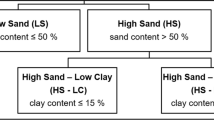Abstract
Corn yield, topography and soil characteristics were sampled on a 26 ha area of a centre pivot irrigated cropland. The aim of the study was to determine relationships between corn yield, field topography and soil characteristics. The study was carried out in the Alentejo region of Portugal. Corn yield was measured with a combine harvester fitted with a grain-flow sensor and positioned by means of the Global Positioning System (GPS). A grid-based digital elevation model (DEM) with 1-m resolution was constructed and several topographic attributes were calculated from the DEM: the local slope gradient (S), profile curvature (Curv), specific catchments area (SCa), and a steady-state wetness index (W). Yield and topographical attributes were computed for areas of radius 5, 10, 25 and 50 m, being considered its maximum, minimum, range and average values. The soil was systematically sampled with a mechanical probe for a total of 109 soil profiles used for analysis of the following soil superficial (<0.30 m) characteristics: extractable phosphorous (P2O5) and extractable potassium (K2O), soil pH, cation exchange capacity (CEC) and exchangeable bases. With centre pivot irrigation systems, the Wave50 index was shown to be useful for the identification of field areas in which low corn yields may be due to lack of water. At the same time, SCa was found to be useful for the identification of field areas in which low yields are due to excess water and drainage problems. Higher positive correlation between pH, Ca and Curv were observed; calcium concentration was found on the transition areas between flat surfaces to concave ones, while lower values were detected in convex and concave areas. Topographical indexes, namely Wave50, SCa and Curv, can be especially helpful in site-specific management for delineating areas where crop yields are more sensitive to extreme water conditions.
Similar content being viewed by others
References
A. Bakhsh D. B. Jaynes T. S. Colvin R. S. Kanwar (2000) ArticleTitleSpatio-temporal analysis of yield variability for a corn-soybean field in Iowa Transactions of the America Society of Agricultural Engineers 43 IssueID1 1–38
C. A. Black (1965) Methods of Analysis. Part 2 American Society of Agronomy Madison, Wiscosin. USA
R. P. Braga (2000) Predicting the Spatial Pattern of Grain Yield under Water Limiting Conditions University of Florida Gainsville, Fla., USA
P. A. Burrough (1986) Principles of Geographical Information Systems for Land Resources Assessment Oxford University Press New York
A. Changere R. Lal (1997) ArticleTitleSlope position and erosional effects on soil properties and corn production on a Miamian soil in central Ohio Journal of Sustainable Agriculture 11 5–21
J. Desmet (1997) ArticleTitleEffects of interpolation errors on the analysis of DEMs Earth Surface Processes and Landforms 22 563–580
InstitutionalAuthorNameEnvironmental Systems Research Institute (ESRI) (1999) ArcView Spatial analyst extension ESRI Redlands, CA, USA
InstitutionalAuthorNameEnvironmental Systems Research Institute (ESRI) (2001) ArcGIS Geostatistical Analyst ESRI Redlands, CA, USA
FAO, ISRIC and ISSS, 1998. World Reference Base for Soil Resources. World Soil Resources Report No. 84. Food and Agriculture Organization of the United Nations. Rome. 88 pp.
S. K. Jenson J. O. Domingue (1988) ArticleTitleExtracting topographic structure from digital elevation data for geographic information system analysis Photogrammetric Engineering and Remote Sensing 54 1593–1600
J. A. Lamb R. H. Dowdy J. L. Anderson G. W. Rehm (1997) ArticleTitleSpatial and temporal stability of corn yields Journal of Production Agriculture 10 IssueID3 410–414
I. D. Moore G. L. Burch D. H. MacKenzie (1988) ArticleTitleTopographic effects on the distribution of surface soil water and the location of ephemeral gullies Transactions of the America Society of Agricultural Engineers 31 IssueID4 1098–1107
I. D. Moore P. E. Gessler G. A. Nielsen G. A. Peterson (1993a) ArticleTitleSoil attribute prediction using terrain analysis Soil Science Society of America Journal 57 443–452
I. D. Moore A. K. Turner J. P. Wilson S. K. Jensen L. E. Band (1993b) GIS and land surface-subsurface process modelling M. F. Goodchild O. P. Bradley T. S. Louis (Eds) Environmental modelling and GIS Oxford Univ. Press Oxford, UK 196–230
H. Riehm (1958) ArticleTitleDie ammoniumlaktatessiäure – Methode zur Bestimmung der leichtlöslichen Phosphorsäre in Karbonathaltigböden Agrochimica 3 49–65
P. P. Sharma S. C. Gupta W. J. Rawls (1991) ArticleTitleSoil detachment by single raindrops of varying kinetic energy Soil Science Society of America Journal 55 301–307
A. L. Thompson L. G. James (1985) ArticleTitleWater droplet impact and its effect on infiltration Transactions of the America Society of Agricultural Engineers 28 IssueID5 1506–1510
Thorne, C. R., Zevenbergen, L. W., Burt, T. P. and Butcher, D. P. 1987. Terrain analysis for quantitative description of zero-order basins. In: Erosion and Sedimentation in the Pacific Rim: Proceedings of the Corvallis Symposium, edited by IAHS Press, Publ. No. 165, 121–130, Oregon, USA.
C. Yang C. L. Peterson G. J. Shropshire T. Otawa (1998) ArticleTitleSpatial variability of field topography and wheat yield in the Palouse Region of the Pacific Northwest Transactions of the America Society of Agricultural Engineers 41 IssueID1 17–27
Author information
Authors and Affiliations
Corresponding author
Rights and permissions
About this article
Cite this article
Silva, J.R.M.D., Alexandre, C. Spatial Variability of Irrigated Corn Yield in Relation to Field Topography and Soil Chemical Characteristics. Precision Agric 6, 453–466 (2005). https://doi.org/10.1007/s11119-005-3679-3
Issue Date:
DOI: https://doi.org/10.1007/s11119-005-3679-3




